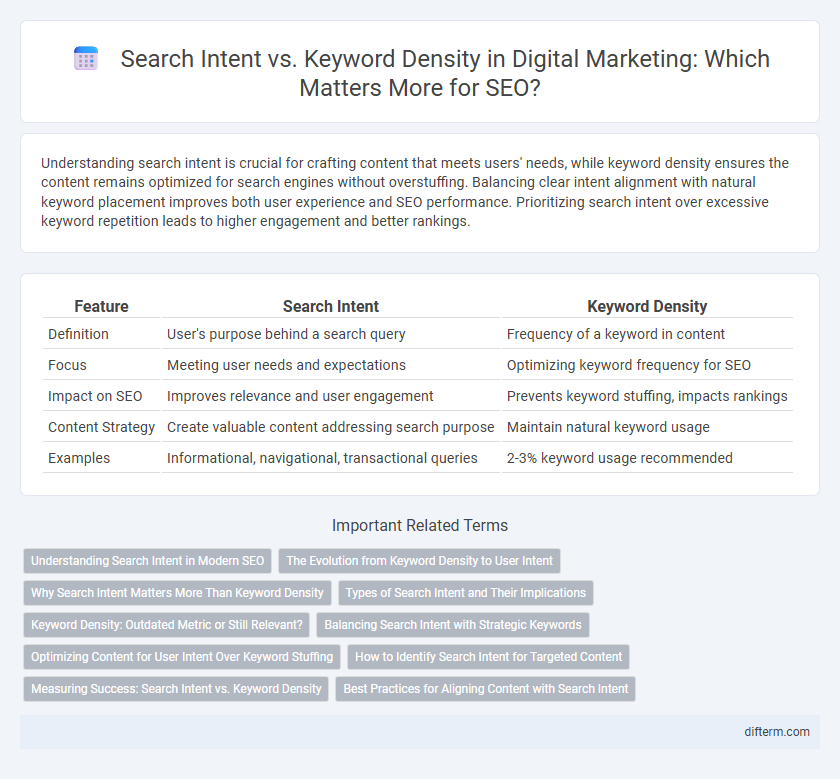Understanding search intent is crucial for crafting content that meets users' needs, while keyword density ensures the content remains optimized for search engines without overstuffing. Balancing clear intent alignment with natural keyword placement improves both user experience and SEO performance. Prioritizing search intent over excessive keyword repetition leads to higher engagement and better rankings.
Table of Comparison
| Feature | Search Intent | Keyword Density |
|---|---|---|
| Definition | User's purpose behind a search query | Frequency of a keyword in content |
| Focus | Meeting user needs and expectations | Optimizing keyword frequency for SEO |
| Impact on SEO | Improves relevance and user engagement | Prevents keyword stuffing, impacts rankings |
| Content Strategy | Create valuable content addressing search purpose | Maintain natural keyword usage |
| Examples | Informational, navigational, transactional queries | 2-3% keyword usage recommended |
Understanding Search Intent in Modern SEO
Understanding search intent in modern SEO is crucial for creating content that aligns with what users are actively seeking, resulting in higher engagement and improved rankings. While keyword density measures how often a term appears, prioritizing search intent ensures content satisfies the user's underlying need, whether informational, navigational, or transactional. Optimizing for search intent over mere keyword frequency enhances relevancy and drives targeted organic traffic more effectively.
The Evolution from Keyword Density to User Intent
Search intent has transformed marketing strategies by shifting the focus from keyword density to understanding the user's purpose behind a query. Modern SEO emphasizes creating content that aligns with informational, navigational, or transactional intents, enhancing relevance and engagement. This evolution prioritizes meaningful interactions over keyword stuffing, driving higher organic traffic and improved conversion rates.
Why Search Intent Matters More Than Keyword Density
Search intent prioritizes understanding user goals behind queries, driving more relevant and engaging content than merely focusing on keyword density. Algorithms increasingly reward pages that satisfy intent by matching user expectations, improving search rankings and click-through rates. Emphasizing search intent aligns SEO strategies with audience needs, fostering higher conversion rates and sustainable organic traffic growth.
Types of Search Intent and Their Implications
Understanding the types of search intent--informational, navigational, transactional, and commercial investigation--plays a crucial role in optimizing content for user queries. Aligning keyword density with the specific intent ensures that content effectively addresses user needs, enhancing relevance and engagement. Marketers must tailor keyword strategies to each intent type to improve SEO performance and drive targeted traffic.
Keyword Density: Outdated Metric or Still Relevant?
Keyword density, once a staple of SEO strategies, is now viewed as a less critical factor compared to search intent, which better aligns content with user needs. Despite its decline in importance, maintaining a natural keyword presence can still aid in signaling topic relevance to search engines without risking keyword stuffing penalties. Modern SEO emphasizes semantic relevance and user experience over rigid keyword metrics, reinforcing the need for balanced keyword integration.
Balancing Search Intent with Strategic Keywords
Balancing search intent with strategic keywords is essential for effective marketing campaigns that drive targeted traffic. Prioritizing user intent ensures content aligns with what searchers seek, while incorporating relevant keywords boosts visibility on search engines. Optimizing keyword density without compromising on search intent leads to higher engagement and improved conversion rates.
Optimizing Content for User Intent Over Keyword Stuffing
Optimizing content for user intent enhances search engine rankings more effectively than focusing solely on keyword density because it aligns with what users are actively seeking. Search engines prioritize semantic relevance and natural language patterns, rewarding content that satisfies the underlying intent behind queries. High-quality, intent-driven content improves engagement metrics and reduces bounce rates, driving sustainable organic traffic growth.
How to Identify Search Intent for Targeted Content
Identifying search intent for targeted content begins with analyzing user queries to understand whether they are informational, navigational, or transactional. Tools like Google Analytics, keyword research platforms, and SERP analysis help marketers decode intent by revealing common questions, preferred content types, and user behavior patterns. Optimizing content around clear search intent enhances relevance, engagement, and conversion rates while maintaining effective keyword density without keyword stuffing.
Measuring Success: Search Intent vs. Keyword Density
Measuring success in marketing hinges on understanding search intent, which drives qualified traffic by aligning content with user needs, rather than merely focusing on keyword density. High keyword density can lead to keyword stuffing, hurting search rankings and user experience, while optimizing for search intent improves relevance and engagement metrics. Analyzing behavioral signals such as click-through rates, bounce rates, and conversion rates offers a more accurate gauge of content performance than keyword frequency alone.
Best Practices for Aligning Content with Search Intent
Understanding search intent is crucial for creating content that meets users' needs, while optimizing keyword density enhances content relevance without overstuffing. Best practices include conducting thorough intent analysis to classify queries as informational, navigational, or transactional and tailoring content structure accordingly. Maintaining a natural keyword density between 1-2% ensures search engines accurately interpret the content's focus, improving rankings and user engagement.
Search Intent vs Keyword Density Infographic

 difterm.com
difterm.com